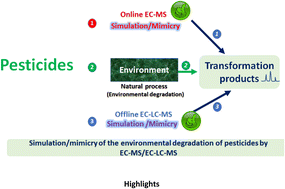Electrochemistry coupled with mass spectrometry for the prediction of the environmental fate and elucidation of the degradation mechanisms of pesticides: current status and future prospects
Abstract
One of the crucial steps in the development of a new pesticide (active molecule) is predicting its environmental and in vivo fate, so as to determine potential consequences to a living organism's health and ecology as a whole. In this regard, pesticides undergo transformation processes in response to biotic and abiotic stress. Therefore, there is a need to investigate pesticide transformation products (TPs) and the formation processes they could undergo during the manufacturing process and when discharged into the ecosystem. Although methods based on biological in vitro and in vivo experimental models are tools of choice for the elucidation of metabolic pathways of pesticides (xenobiotics in general), electrochemistry-based techniques offer numerous advantages such as rapid and low-cost analysis, easy implementation, low sample volume requirement, no matrix effects, and miniaturization to improve the performance of the developed methods. However, for greater efficiency, electrochemistry (EC) should be coupled with analytical techniques such as mass spectrometry (MS) and sometimes liquid chromatography (LC), leading to the so-called EC-MS and EC-LC-MS hybrid techniques. In this review, past studies, current applications and utilization of EC-MS and EC-LC-MS techniques for the simulation of environmental fate/degradation of pesticides were reviewed by selected studies with chemical transformation, structures of metabolites, and some experimental conditions. The current challenges and future trends for the mimicry and prediction of the environmental fate/degradation of pesticides based on electrochemical methods combined with mass spectrometry were highlighted.

- This article is part of the themed collections: Contaminant remediation and fate and Environmental Science: Processes & Impacts: Recent Review Articles


 Please wait while we load your content...
Please wait while we load your content...